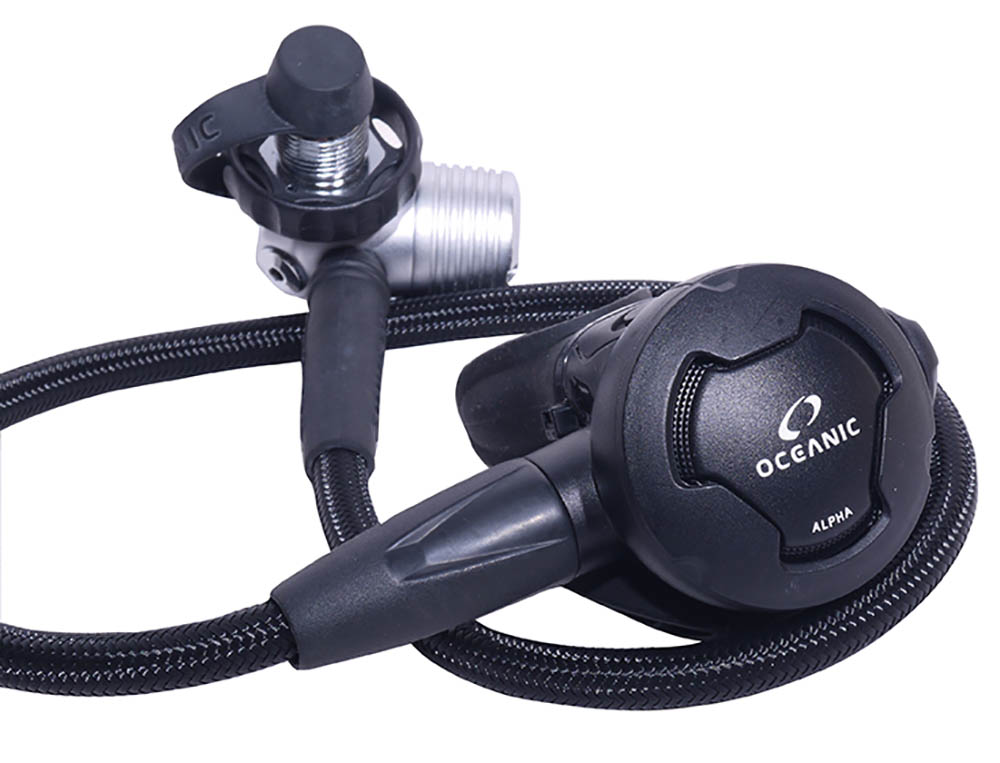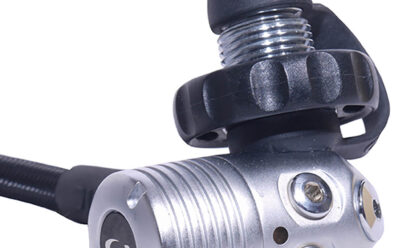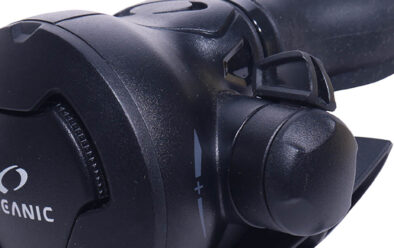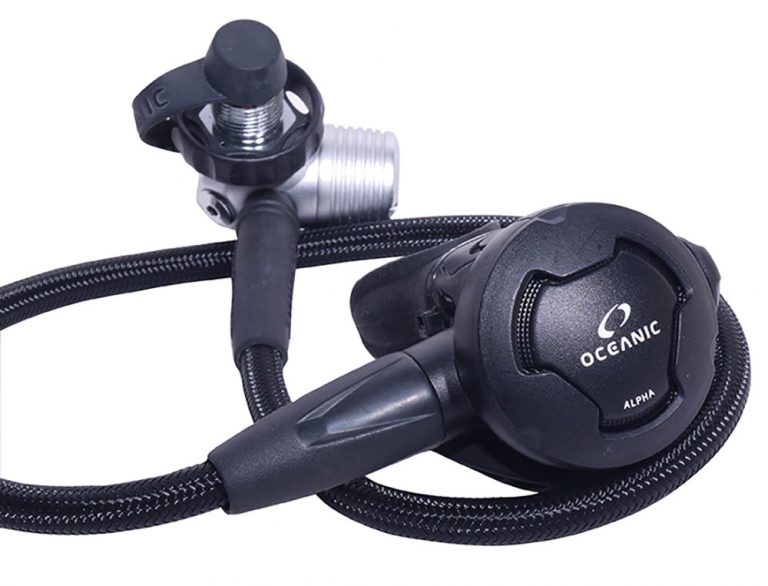Oceanic Alpha 10 SPX

Breathing is believing. But first, some context.
Years ago, I got into an argument with an equipment retailer. One of my students was lining up to buy his first regulator. I advised Garth to choose a high-performance model.
The dealer was adamant that he shouldn’t, rudely telling his potential customer: “You’re not good enough for a premium valve yet”.
He insisted that Garth should buy a cheap model, one I suspect he wanted to clear from his stocks. Back then, the main independent guide to regulator performance came from DIVER’s ANSTI breathing-machine consumer tests and occasional US Navy Experimental Diving Unit lab reports, or from what other divers used or would let you try.
The most basic received wisdom was cost – the higher the price, the better the reg breathed.
A regulator can last for as long as you can get the spares needed for servicing – at least 10 years, so the demands you make on it could well change over time, perhaps as you move into tech, for instance.
Choosing a first reg that can progress with your future needs can be far cheaper than regularly upgrading or, most costly of all, compromising your safety by pushing a valve beyond its specifications.
Garth was not diving deep but was just a few dives away from doing so, and encountering some pretty wild currents at the same time.
None of us already making those dives trusted to cheap regs. So Garth bought one of the easiest-breathing and expensive regulators then made, leaving the “beginner” valve for the next sucker.
Breathing standards
Surprisingly, consumers have only comparatively recently been offered any official guidance to a regulator’s performance. EN250 lays down limits for how hard a regulator can make you work to inhale and exhale, if its maker wants to sell that regulator in the EU – including, as I write, the UK.
The original standard set limits for a single diver breathing from the regulator. However, since the 1980s octopus use has been mandated for all students trained through PADI, and is ubiquitous among today’s recreational divers of all persuasions.
In 2014, the EU standards made a stab at catching up. EN250A was a higher benchmark, requiring the regulator to prove during breathing-machine tests that it can supply two divers breathing moderately hard at 30m as easily as it could supply one diver breathing at 50m, as per the earlier EN250 requirement.
So for anyone who plans to carry an octopus, an EN250A-certified regulator is the way forward.
I’ve been on a steep learning curve since I started reviewing equipment for DIVER. Regulator performance among budget models has particularly astounded me, but I had put this down to snazzy balanced first-stage designs.
What happens when you take a seemingly super-basic first stage and place it at the heart of a really low-cost regulator?
Oceanic is the first company to volunteer to let me try such a model, the EN250A-certified Alpha 10 SPX. It’s been an eye-opener.
The First Stage
SPX refers to the first stage, a neat, compact design. The ribbing helps draw heat into the first stage from the surrounding water to inhibit icing on coldwater dives. In fact it’s coldwater-rated, so its EN250A certification includes approval for diving in water as cold as 4°C.
The EN test is carried out at 50m in fresh water for five minutes, and the valve must not freeflow when breathed fairly hard. In reality, that’s not how most leisure divers diving inland through a UK winter operate but, while the water might be colder than 4°C and the dive far longer, it’s also usually shallower and more relaxed, so regulator cooling is lessened.
In practice the EN coldwater rating seems a good guide to real world reg anti-icing reliability, though coldwater diving procedures should also be followed.

There are three medium-pressure take-offs on one side and two on the other, with an hp port on the right and left. The ports are fixed in position, with the mp ones slightly angled, making for easy hose layouts.
The Alpha 10 SPX has a flexi-hose, so coils up tightly for packing. I used a DIN connection, which I prefer, but a yoke model is available.
What makes the SPX interesting is that it’s an unbalanced piston design. This is mechanically the simplest, and so the least expensive, type of first stage to make. Its only moving part is a hollow piston through which air must pass to get from tank to second stage and into your lungs.
The high-pressure air entering the first stage from your cylinder pushes the piston upwards, so the air can flow through it from the SPX’s hp chamber into another air chamber at the piston’s other end. There it is reduced to a much lower pressure of around 9 bar, termed medium pressure, needed to supply your second stage, octopus and direct feeds.
Helping the hp air to force the piston into the open position is a spring. This exerts an opening force equivalent to the mp – about 9 bar. Water pressure adds to this opening force, accounting automatically for changes in pressure as you descend and ascend through the water column.
So, three forces – incoming hp air from your tank, the fixed-strength spring and the variable force of the surrounding water – all work together to keep the piston open.
But if it was always open, your regulator would simply freeflow and dump all your air.
Inside the mp chamber, once you stop inhaling air quickly backs up. This causes the pressure to rise and pushes the piston back into the closed position, shutting the air off.
Even though the mp is only around 9 bar, it’s spread over a much larger area of the piston, which is a disc the size of a small coin at its mp end compared to the hp end, which is only about the diameter of a straw.
So mp can easily overcome the higher combined tank pressure, water pressure and spring tension and shut off the air-flow.
When you inhale again, air-pressure drops in the mp chamber, the piston lifts and, once again, you get air for the duration of your breath.
In the costlier balanced-piston first-stage design, hp air from your tank surrounds the hp end of the piston but does not directly push on it. So falling tank pressure has almost no effect on ease of inhalation.
In the unbalanced model the pressure inside the mp chamber stays much the same through the dive. However, as your tank pressure falls as you breathe down your air-supply, the opening force also reduces. This should make it a little harder to open the valve and get the air flowing.
This is why, traditionally, unbalanced-piston regulators are thought of as becoming harder to breathe from below reserve tank pressures, say around 50 bar. Some divers used to see this as a plus, because it provided a physical warning that they were getting low on air.
The unbalanced piston was also considered poor at supplying high flow-rates of gas – exactly what might be needed if you share air through your octopus.
Appeared in DIVER April 2020
The Second Stage
The Alpha 10 second stage looks conventional, but hidden inside is its pneumatically balanced mechanism. This feature was for many years found only on top-of-the-line second stages. It’s a refinement that makes the first part of the inhalation cycle easier than it is without it.
In conventional second stages, as you inhale the second-stage diaphragm collapses inwards, pushing down on a lever. This opens a valve beside the hose leading from your first stage, and air flows into your lungs.
To keep the valve closed until you need air and prevent a freeflow, a spring is used. Because the force of the air coming from your first stage increases with depth, this spring must be strong enough to hold it back on the deepest dives you might make. So on shallow dives it is stronger than it needs to be.

To “crack” your valve to get the air flowing, you use your lung-power to overcome the closing force of this spring. This takes effort and means, among other things, that you’ll use more air.
The pneumatic balancing used in the Alpha 10 overcomes this problem by surrounding the spring in an air-pocket.
The pressure of this air increases as you go deeper and decreases as you ascend.
In effect it works to make the spring stronger or weaker, so the effort you invest in cracking the second stage is always the minimum needed, regardless of depth.
Once you crack the valve and get the air flowing, the usual venturi takes over and keeps the valve open with little further effort on your part. A dive/pre-dive switch is provided – this should always be set to the dive position when used under water.
Like the SPX first stage, the Alpha 10 second stage is certified for use in water as cold as 4°C.
In Extreme Use
The Alpha 10 SPX was first assessed on a 30m octopus-sharing test, alongside a slightly more expensive mid-range regulator from another major brand and a premium valve costing twice as much from a third respected manufacturer.
The sharing exercise is to get a feel for how easily a regulator breathes with two divers inhaling and exhaling at a moderate work rate.
In theory, the machine tests required to certify the Alpha 10 SPX confirm its performance.
These test the regulator with both second stages being breathed at the same time at a simulated depth of 30m, and require that each second stage supplies 250 litres of air over a one-minute cycle.
Critically, the machine can measure true work of breathing – essentially, how hard you have to work to draw in and exhale each breath. There are set EN limits for this.
Our manned test isn’t nearly so scientific, but it provides both reassurance and subjective feedback. With Dennis Santos, a diver with 50 years’ experience, I took the Alpha 10 SPX to 30m and we tried our damnedest to outbreathe it.
Oceanic had not supplied an octopus, so I attached another manufacturer’s high-performance second stage for Dennis to breathe from. We ran the test over two minutes, because it takes time to get your breathing rate up.
These tests are uncomfortable, because you build up a lot of carbon dioxide and it is this that makes you begin to feel breathless, rather than the regulator, if it’s any good.
But in the past it was quite possible to “beat the lung”, meaning that the regulator’s ability to supply sufficient air was being exceeded by the divers’ need for it.
So, the big question – is the basic, low-cost and unpretentious Oceanic Alpha 10 SPX any good in a crisis?
You betcha. Inhalation effort was pretty much indistinguishable from its two competitors tested immediately before and after. I could detect no increase in inhalation effort, even as my need for air rocketed.
While a simple analogue pressure-gauge isn’t as accurate as I’d like for these tests, it seems that Dennis and I ploughed through enough air to confidently say that we at least met the 500 litres per minute threshold.
In Normal Use
In normal use the Oceanic breathed very well, all the way down from 280 bar to about 30. I didn’t notice a change in performance in the reserve range, so the Alpha 10 SPX seemed to me to breathe as well as a balanced first stage.
The non-slip DIN handwheel is easy to do up and undo with wet hands, and the array of ports makes configuring hoses easy.
The second stage is lightweight, so very comfortable on long dives, with not a hint of jaw fatigue. It’s easy to clear upside-down, as can happen in the confusion of a sharing situation, either by exhaling or purging.
The exhaust T diverts bubbles away from your field of view nicely.
Conclusion
There’s a great deal to commend in the Oceanic Alpha 10 SPX. It’s a very easy breathe – not “for the price” but by any standard, including of course EN250A. It’s an excellent primary reg in its own right, and would also work well for a budget pony-valve or for stage-bottle use within the 40% nitrox limits. Highly recommended.
Specs
TESTER> Steve Warren
PRICE> £270
FIRST STAGE> Unbalanced piston
SECOND STAGE> Pneumatically balanced
PORTS> 4mp, 2hp
WEIGHT> 230gm plus hose
CONTACT> oceanicworldwide.com

